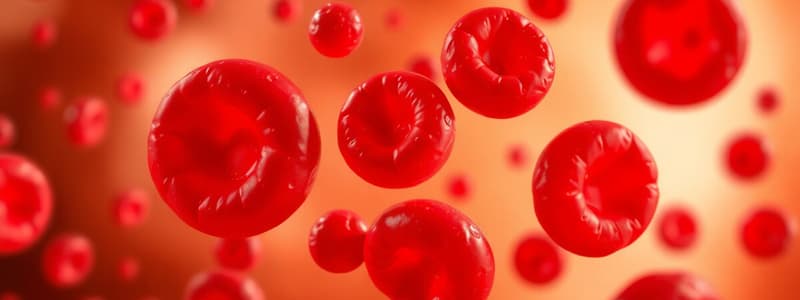Podcast
Questions and Answers
What is the role of intrinsic factor in vitamin B12 absorption?
What is the role of intrinsic factor in vitamin B12 absorption?
- Intrinsic factor helps in the synthesis of vitamin B12 in the stomach.
- Intrinsic factor inhibits vitamin B12 absorption in the ileum.
- Intrinsic factor is not involved in vitamin B12 absorption.
- Intrinsic factor binds to vitamin B12 in the stomach, facilitating its absorption in the ileum. (correct)
What subjective data would you expect to find in a patient with pernicious anemia?
What subjective data would you expect to find in a patient with pernicious anemia?
- Increased energy levels and vitality
- Increased appetite and thirst
- Improved sense of balance and coordination
- Palpitations, nausea, dysphagia, and indigestion (correct)
Which objective data is commonly observed in patients with pernicious anemia?
Which objective data is commonly observed in patients with pernicious anemia?
- Increased muscle mass and strength
- Normal blood pressure and heart rate
- Smooth and erythematous tongue, infection of teeth and gums (correct)
- Improved cognitive function and memory
Which diagnostic test is used to assess red blood cell size in patients with pernicious anemia?
Which diagnostic test is used to assess red blood cell size in patients with pernicious anemia?
What is the primary drug therapy for pernicious anemia?
What is the primary drug therapy for pernicious anemia?
What is the recommended frequency of vitamin B12 injections after initial therapy for pernicious anemia?
What is the recommended frequency of vitamin B12 injections after initial therapy for pernicious anemia?
Which of the following nursing interventions is crucial for managing a patient with pernicious anemia?
Which of the following nursing interventions is crucial for managing a patient with pernicious anemia?
What dietary recommendations should be given to a patient with pernicious anemia?
What dietary recommendations should be given to a patient with pernicious anemia?
What is the primary cause of pernicious anemia?
What is the primary cause of pernicious anemia?
What is an important nursing intervention for patients with leukemia regarding infection control?
What is an important nursing intervention for patients with leukemia regarding infection control?
Which dietary recommendation should be provided to patients with leukemia?
Which dietary recommendation should be provided to patients with leukemia?
Which characteristic is associated with the pathophysiology of leukemia?
Which characteristic is associated with the pathophysiology of leukemia?
What should be avoided to reduce infection risk for patients with leukemia?
What should be avoided to reduce infection risk for patients with leukemia?
What is a key characteristic of anemia?
What is a key characteristic of anemia?
Which of the following can lead to anemia due to impaired production of red blood cells?
Which of the following can lead to anemia due to impaired production of red blood cells?
What symptom might indicate a severe loss of blood volume in an individual with anemia?
What symptom might indicate a severe loss of blood volume in an individual with anemia?
Which diagnostic test is most relevant for detecting anemia?
Which diagnostic test is most relevant for detecting anemia?
What is the main focus of medical management for anemia?
What is the main focus of medical management for anemia?
Which of the following could be an objective data point observed in a patient with anemia?
Which of the following could be an objective data point observed in a patient with anemia?
What is a common clinical manifestation of chronic mild anemia?
What is a common clinical manifestation of chronic mild anemia?
What is the primary cause of tissue pain in internal hemorrhage?
What is the primary cause of tissue pain in internal hemorrhage?
Which symptom may not be immediately evident after severe blood loss?
Which symptom may not be immediately evident after severe blood loss?
What is an essential intervention for a patient experiencing hemorrhage?
What is an essential intervention for a patient experiencing hemorrhage?
What does one unit of packed RBCs typically increase in hemoglobin levels?
What does one unit of packed RBCs typically increase in hemoglobin levels?
Which of the following is a common symptom of decreased renal perfusion?
Which of the following is a common symptom of decreased renal perfusion?
What must be monitored frequently in a patient with hemorrhage?
What must be monitored frequently in a patient with hemorrhage?
Which factor is essential for Vitamin B12 absorption?
Which factor is essential for Vitamin B12 absorption?
What is a likely consequence of atrophy or partial gastrectomy in the stomach?
What is a likely consequence of atrophy or partial gastrectomy in the stomach?
Which of the following is NOT a nursing intervention for patients at risk of hemorrhage?
Which of the following is NOT a nursing intervention for patients at risk of hemorrhage?
What is the primary treatment approach for patients with Polycythemia Vera?
What is the primary treatment approach for patients with Polycythemia Vera?
Which of the following is a possible cause of secondary Polycythemia Vera?
Which of the following is a possible cause of secondary Polycythemia Vera?
What is an important nursing intervention for managing patients with Polycythemia Vera?
What is an important nursing intervention for managing patients with Polycythemia Vera?
Which of the following diagnostic tests is used to identify Polycythemia Vera?
Which of the following diagnostic tests is used to identify Polycythemia Vera?
Flashcards
Anemia
Anemia
A condition with below-normal red blood cells, hemoglobin, and hematocrit.
Causes of Anemia
Causes of Anemia
Includes blood loss, hemolysis, impaired production, and nutritional deficiencies.
Clinical Manifestations of Anemia
Clinical Manifestations of Anemia
Symptoms include fatigue, dizziness, and shortness of breath due to low oxygen.
Sudden Blood Loss Effects
Sudden Blood Loss Effects
Signup and view all the flashcards
Chronic Anemia Symptoms
Chronic Anemia Symptoms
Signup and view all the flashcards
Diagnostic Tests for Anemia
Diagnostic Tests for Anemia
Signup and view all the flashcards
Medical Management of Anemia
Medical Management of Anemia
Signup and view all the flashcards
Clinical signs vs Lab values
Clinical signs vs Lab values
Signup and view all the flashcards
Internal hemorrhage symptoms
Internal hemorrhage symptoms
Signup and view all the flashcards
Delayed RBC loss detection
Delayed RBC loss detection
Signup and view all the flashcards
Assessment subjective data
Assessment subjective data
Signup and view all the flashcards
Assessment objective data
Assessment objective data
Signup and view all the flashcards
Blood volume restoration in shock
Blood volume restoration in shock
Signup and view all the flashcards
Intrinsic factor role
Intrinsic factor role
Signup and view all the flashcards
Pernicious Anemia
Pernicious Anemia
Signup and view all the flashcards
Nursing interventions
Nursing interventions
Signup and view all the flashcards
Medical Management
Medical Management
Signup and view all the flashcards
Hematopoietic Stem Cell Transplantation (HSCT)
Hematopoietic Stem Cell Transplantation (HSCT)
Signup and view all the flashcards
Polycythemia Vera Etiology
Polycythemia Vera Etiology
Signup and view all the flashcards
Clinical Manifestations
Clinical Manifestations
Signup and view all the flashcards
Subjective Data
Subjective Data
Signup and view all the flashcards
Objective Data
Objective Data
Signup and view all the flashcards
Diagnostic Tests for Polycythemia Vera
Diagnostic Tests for Polycythemia Vera
Signup and view all the flashcards
Increased Blood Viscosity Effects
Increased Blood Viscosity Effects
Signup and view all the flashcards
Patient Education Topics
Patient Education Topics
Signup and view all the flashcards
Intrinsic Factor
Intrinsic Factor
Signup and view all the flashcards
Vitamin B12 Functions
Vitamin B12 Functions
Signup and view all the flashcards
RBC Membrane Stability
RBC Membrane Stability
Signup and view all the flashcards
Clinical Manifestations of B12 Deficiency
Clinical Manifestations of B12 Deficiency
Signup and view all the flashcards
Diagnostic Tests for B12 Deficiency
Diagnostic Tests for B12 Deficiency
Signup and view all the flashcards
Vitamin B12 Replacement Therapy
Vitamin B12 Replacement Therapy
Signup and view all the flashcards
Diet for B12 Deficiency
Diet for B12 Deficiency
Signup and view all the flashcards
Neutropenic precautions
Neutropenic precautions
Signup and view all the flashcards
G-CSF (Neupogen)
G-CSF (Neupogen)
Signup and view all the flashcards
Signs of infection
Signs of infection
Signup and view all the flashcards
Etiology of leukemia
Etiology of leukemia
Signup and view all the flashcards
Classification of leukemia
Classification of leukemia
Signup and view all the flashcards
Study Notes
Disorders Associated with Erythrocytes and Leukocytes
- Anemia: Characterized by below-normal levels of red blood cells, hemoglobin, and hematocrit, leading to insufficient oxygen delivery to tissues and cells. Caused by factors like hemorrhage, increased destruction of red blood cells (hemolysis), impaired production of red blood cells, nutritional deficiencies (e.g., iron deficiency). Peripheral circulation compensates by shunting blood to vital organs, causing hypoxia elsewhere.
Pathophysiology of Anemia
- Loss of red blood cells: Due to hemorrhage.
- Increased destruction of red blood cells (hemolysis): Implies red blood cells are destroyed faster than the body can replace them.
- Impaired production of red blood cells (bone marrow depression or failure): Bone marrow is unable to create new red blood cells at a sufficient rate.
- Nutritional deficiencies: Such as long-term iron deficiency, leading to an inadequate supply of essential nutrients for red blood cell production.
- Loss of oxygen-carrying elements: In the blood, causing a supply/demand imbalance in vital organs.
Clinical Manifestations of Anemia
- Sudden loss of 1/3 of blood volume: Hypotension, respiratory distress, altered mental status.
- Acute loss (Hgb below 5g/mL): Severe hypotension, myocardial infarction, stroke, severe altered mental status, death are potential complications.
- Chronic mild anemia: May be asymptomatic, unless detected in lab. General malaise, heart palpitations, shortness of breath on exertion, dizziness/lightheadedness might be present.
Assessment of Anemia
- Subjective data: Weakness, dyspnea, fatigue, vertigo, headaches, and sometimes insomnia.
- Objective data: Observing signs and symptoms of shock, bleeding, pallor, and monitoring laboratory values.
Diagnostic Tests for Anemia
- Complete blood count (CBC): Decreased RBCs, hemoglobin, and hematocrit.
- Decreased serum iron, total binding capacity, and serum ferritin levels: Indicate a deficiency in iron, which is crucial for red blood cell production.
- Increased reticulocyte count: Due to immature RBCs. Suggests the bone marrow is working to compensate for the loss of red blood cells.
- Bone marrow biopsy: Revealing abnormalities.
- Peripheral blood smears: Identifying cell shape/color abnormalities.
- Decreased vitamin B12 level: Associated with some types of anemia.
Medical Management of Anemia
- Intervention depends on the cause: May require blood transfusions, iron replacement, or addressing underlying conditions like hemorrhage.
Nursing Interventions and Patient Teaching for Anemia
- A comprehensive approach tailored to the specific type and stage of anemia is required.
Jehovah's Witnesses
- Opposed to homologous blood transfusions: Due to religious beliefs.
- May agree to autologous transfusions: Using the patient's own blood previously collected.
- May use volume expanders: To preserve circulatory volume.
Hypovolemic Anemia (Blood Loss Anemia)
- Deficiencies in RBCs and other components: Due to low circulating blood volume from hemorrhage.
- Blood loss of 1000 mL or more: Considered severe; less than 500 mL may be tolerated.
- Causes: Surgery, GI bleeding, menstruation, trauma, burns.
- Leads to hypovolemic shock: Sudden reduction in total blood volume.
Studying That Suits You
Use AI to generate personalized quizzes and flashcards to suit your learning preferences.



